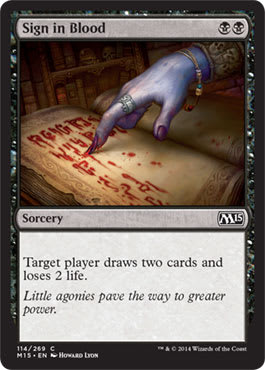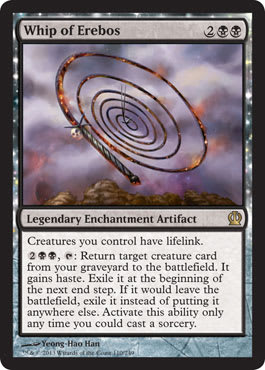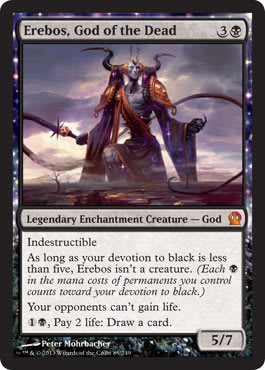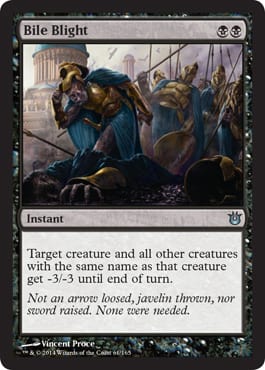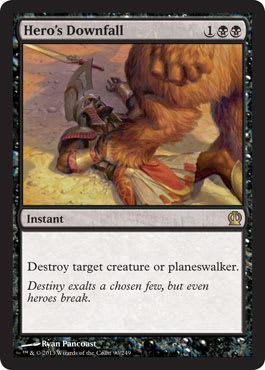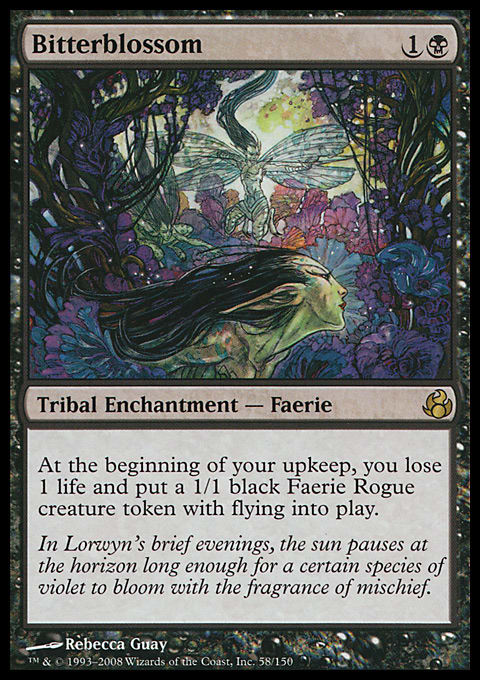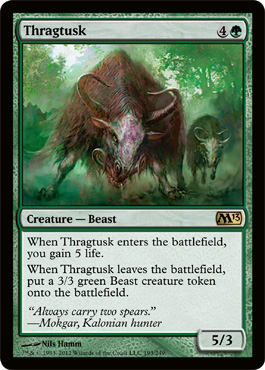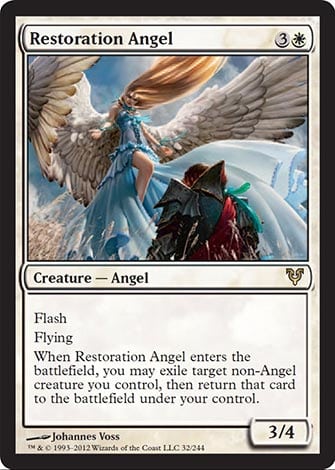Hey, everyone!
It’s been a while since I wrote an article, but I love my Standard and Modern decks at the moment, and I want to talk about them. I have an update on the Mono-Black Devotion deck I played at Pro Tour Magic 2015 as well as an update to the R/W/U Flash deck I have been championing for the last year for Modern. To top things off, I want to go over my testing process for Pro Tour M15 because I didn’t practice with a team due to work and other commitments, but I still had a good run in Standard. I messed up the Draft portion, but I know what went wrong.
Standard
To kick things off, let’s begin with Standard.
Here’s the list I registered at Pro Tour M15:
Mono-Black Devotion ? Magic 2015 Standard | Kyle Boggemes
- Creatures (16)
- 4 Desecration Demon
- 4 Gray Merchant of Asphodel
- 4 Lifebane Zombie
- 4 Pack Rat
- Spells (19)
- 1 Ultimate Price
- 2 Devour Flesh
- 3 Bile Blight
- 3 Hero's Downfall
- 2 Sign in Blood
- 4 Thoughtseize
- 3 Underworld Connections
- 1 Whip of Erebos
- Lands (25)
- 18 Swamp
- 2 Temple of Deceit
- 4 Mutavault
- 1 Urborg, Tomb of Yawgmoth
- Sideboard (15)
- 3 Duress
- 1 Pithing Needle
- 2 Pharika's Cure
- 3 Doom Blade
- 2 Erebos, God of the Dead
- 3 Nightveil Specter
- 1 Underworld Connections
I know what you’re thinking already: “Kyle, why are you telling us about Mono-Black Devotion? This deck is boring. I’ve seen it a thousand times!”
My answer is that this deck was not represented at the top tables as much as it has been in the past, which makes it a great time to strike with your favorite Rat. I went 7–3 with this deck and would have cashed the tournament if my Drafts went better.
Rather than give a round-by-round recollection of my Standard matches, I just want to briefly discuss what I liked and disliked about the deck.
Props
- Lifebane Zombie was significantly better than Nightveil Specter in the main deck because the green matchups can be difficult without it.
- Nightveil Specter was great in the sideboard because it blocks Chandra's Phoenix and can also dominate the mirror match.
- Two was the perfect number of copies of Sign in Blood. The deck flows better than before.
Slops
- Whip of Erebos didn’t meet my expectations. It is weak after sideboard in the mirror because Erebos, God of the Dead shuts off the lifelink ability. It would have been better as a main-decked copy of Erebos to hose the mirror. The Whip was also for Azorius Control decks, but I had too many 4-drops after sideboard, so I had to cut a Desecration Demon. This means I had too many cards that performed a similar function.
- I thought I was respecting the mirror by playing three copies of Bile Blight, but there were still many games that ended with me dying to a horde of Rats.
I don’t have much negative to say about the deck because I was really happy with the list. Two of my losses were to Thoughtseize into Pack Rat, and the other was to R/G Devotion. I don’t think there’s a deck in the format that can handle Mono-Black Devotion’s nut draw, so things could have gone worse.
Here’s the list I’m playing after the Pro Tour:
Main deck:
Sideboard:
−1 Doom Blade
+1 Duress
I don’t want four copies of Hero's Downfall in the main deck because there are so many 3-drops. With that being said, I want a fourth copy against Jund Monsters and Jund ’Walkers. There can also be corner cases in which your 2-drop removal doesn’t line up well, and the one-size-fits-all spell gets the job done.
Pithing Needle is weaker at this point because there are more Planeswalkers for green decks to play. It used to be the case that Green Devotion had four Garruk, Caller of Beasts and Jund Monsters had four Domri Rade. Now that we have so many options, Pithing Needle hits fewer permanents and is less dependable.
The additional Pharika's Cure is in the sideboard to combat Rabble Red. That deck can be scary, and it’s nice to have a clean answer to the early threats. I also have a good board plan against burn by combining the Cures with the Nightveil Specters.
Pro Tour M15 shook up Standard, but it’s important to not lose sight of decks that are inherently powerful. Every opponent I faced not only knew what I was playing, but also wouldn’t play his or her deck if he or she didn’t think his or her matchup was good against Mono-Black Devotion. Even with those things being true, I still had a good record. Good decks are good.
I didn’t play any games with this deck before the Pro Tour because I focused on Limited leading up to the event. I asked myself why I would spend time preparing for one format when I do horribly but post a solid record with a deck I didn’t play actual games with. The important thing to do is practice when you can, regardless of past events.
You may be asking yourself why I would think of playing the boogeyman of the format after I won Grand Prix Cincinnati with Esper Control. The reason I tried a “new” deck was that I wanted to be proactive at the Pro Tour. I didn’t see any cool decks featuring M15 cards leading up to the Pro Tour, but the best ideas are often hidden until the big dance. I would rather not play a reactive strategy just in case there is a breakout deck. There is no strategy I’m afraid of if I just play Thoughtseize into Pack Rat. LSV has a similar strategy for Pro Tours. He loves to durdle, but he is usually found playing an aggressive deck at high-stakes events.
I also have experience playing Mono-Black Devotion deck at the Pro Tour Qualifier level. There have only been a handful of decks at the Pro Tour level in recent memory that were under the radar and took a tournament by storm. Classic examples of this were Elves! in Berlin (2008) and Caw Blade at Pro Tour Paris (2011). Even though these decks were not popular in the weeks leading up to the Pro Tour, they ended up winning and putting many players at the top. Both of these decks were difficult to pilot, which still makes me not want to audible at the last second. Stick to what you know so you can focus on drafting!
I try to stick with the Paulo (PVDR) strategy of choosing the most powerful deck at Pro Tours. Each Pro Tour features a “public enemy number one,” and it is the job of every professional on the planet to come up with a way to crush it. It is often the case in tournaments with shallow card pools that the best deck coming in has a good weekend.
A classic example of where this failed was Pro Tour Hollywood in 2008, where Faeries was the best deck coming into the tournament. There ended up being only a single copy in the Top 8 (played by Paulo), and the best deck for the event ended up being the Reveillark deck because it preyed on the decks that could actually beat Faeries. The archetype put two players into the Top 8 despite it having a horrible matchup against the fae.
The Faerie example was during a time when there were many sets legal for Standard (even Coldsnap!), which made the available card pool large enough to actually defeat the best deck. Mono-Black Devotion was the best deck coming into this event, but the card pool was at the maximum before the fall rotation. I performed well with Mono-Black Devotion, but the deck failed to put a single player into the Top 8.
My only Pro Tour Top 8 involved me playing the boogeyman of the year: Jund. At this time, Worldwake was just released, so there were only six sets legal. Jund was the best deck not because it had a good “strategy,” but rather because it was a collection of awesome cards. Like many other Pro Tours, professional gamers went into the tank for weeks on how to beat the Jund menace. And the result was a Jund mirror match in the finals.
Jund was dethroned as the best deck when Mythic Conscription was released. Like Jund, this deck had the most powerful cards in the format: Jace, the Mind Sculptor, Lotus Cobra, Knight of the Reliquary, and Noble Hierarch. Nobody consistently defeated Jund by playing hate cards; Standard was shaken up by Wizards of the Coast printing more powerful cards for other archetypes. It’s important to realize when you are in a Standard format in which this is the case. Remember how Thragtusk only began to dominate the format when we went to the five set Standard? We went from a Standard format in which powerful strategies could take down the best deck to specific cards being more powerful than the rest.
It’s also important to realize that you must play many games before actually deciding your brew beats the best deck in the format. I don’t think five to ten games will adequately tell you how you can expect to do in a tournament against the boogeyman. It’s a bold statement to say you have a deck that beats the strategy that is heralded as the best. I’ve been playing Magic tournaments for the last thirteen years straight, so I have heard this many times, and it rarely ends up being true. Once you begin to realize that Magic players are subject to the same biases year after year, things start to become more clear.
With my work commitments, I didn’t feel comfortable playing a deck I thought was good against Mono-Black Devotion because I could just accept a fifty-fifty match by playing the mirror.
Notice that my sideboard has Nightveil Specters, which goes against the grain. This is key because I have my own board plan to suit my play style. If I just blindly copied a sideboard from the Internet, I would probably have a bad time because I don’t know the purpose of every card. I didn’t actually test this deck post-board, but I had theories on when to bring cards in and out.
The reality is that you don’t have to form a super team to be able to have a shot at cracking Standard; in many cases, the answer is right in front of you. Use the time you saved stressing about breaking the format to concentrate on Draft. That is a format that does not reward you for playing the best deck. In fact, it becomes painfully obvious what the best colors are to play after three or four Drafts. The early, practice Drafts go well once you identify the dominant strategy, but you are competing against smart opponents at the Pro Tour—they want to take the best cards, too! You need to be comfortable with playing the third- and fourth-best strategies just in case you are forced into a corner.
This was an error I committed in preparing for Pro Tour M15. Red and white appeared to be head-and-shoulders above the other three colors, and I ended up not having a chance to play them in either Draft. My practice Drafts featured me doing very well every time I had a white deck. I was in unfamiliar territory at the Pro Tour when I ended up playing B/G and U/B.
I did a lot of theorizing on how I go about selecting a deck for the Pro Tour. Most of this applies primarily to Standard formats, which is all right because Wizards wants to make it the dominant format on the professional circuit.
Here are my bullet points for the Pro Tour player on the go:
- Begin with the best deck, and play it at whatever tournament you can.
- It is likely that the best deck in the format is proactive. This is a good hedge for a breakout deck because you will be able to punish bad draws.
- Design your own sideboard since everyone plays matchups differently.
- If you don’t have much time to practice, stick with the best deck because there is a very real possibility it is a good choice.
- Spend more time drafting because the best archetypes end up being discovered early and thus overdrafted. The most valuable Pro Tour preparation is spent playing different Draft archetypes.
Modern
Now let’s talk about Modern! We’re in the middle of a PTQ season, and I have had many players asking about an update on my R/W/U Flash deck, so here it is:
R/W/U Flash ? Modern | Kyle Boggemes
- Creatures (10)
- 3 Restoration Angel
- 4 Snapcaster Mage
- 3 Vendilion Clique
- Spells (24)
- 1 Sphinx's Revelation
- 2 Lightning Helix
- 2 Remand
- 2 Spell Snare
- 3 Electrolyze
- 3 Mana Leak
- 3 Path to Exile
- 4 Cryptic Command
- 4 Lightning Bolt
- Lands (26)
- 1 Mountain
- 1 Plains
- 3 Island
- 1 Glacial Fortress
- 1 Sacred Foundry
- 2 Hallowed Fountain
- 2 Steam Vents
- 2 Sulfur Falls
- 2 Tectonic Edge
- 3 Arid Mesa
- 4 Celestial Colonnade
- 4 Scalding Tarn
- Sideboard (15)
- 2 Stony Silence
- 1 Tectonic Edge
- 2 Dispel
- 2 Counterflux
- 1 Wurmcoil Engine
- 1 Keranos, God of Storms
- 2 Magma Spray
- 1 Combust
- 1 Path to Exile
- 2 Engineered Explosives
My recent update came after local ringer Jeff Pan took this deck to the Top 8 of a PTQ. He swapped the fourth Electrolyze with the third Restoration Angel, and I was a fan. Don’t get me wrong; I love Electrolyze, but I had to cut one of the expensive spells to make room for the third Angel.
The third large creature in the main deck was necessary, as we are seeing a rise in the B/G/w Rock decks. Lingering Souls is an uphill battle, and Vendilion Clique does not get it done against decks like that.
The biggest change to the deck is in the sideboard: Tectonic Edge, Wurmcoil Engine, and Keranos, God of Storms. Many players immediately go to Batterskull, but the token dies easily to Liliana of the Veil. Wouldn’t you rather have a big, grindy spell like Wurmcoil Engine or Keranos against B/G/w instead?
Wurmcoil Engine doesn’t die to Dismember and leaves tokens behind when sacrificed to Liliana of the Veil. It does die to Slaughter Pact, whereas the Germ token created by Batterskull is immune. I like the engine against Maelstrom Pulse because it’s not guaranteed you cast Batterskull with the extra 3 mana available. The Rock decks don’t have Path to Exile, which means you will always have the tokens.
As you can see, I have been very pleased with Flash in Modern, as I have made few updates and had a blast playing it. Give it a shot at your next PTQ or local event!
Thanks for reading,
Kyle















